F. Duncan M. Haldane
Biographical
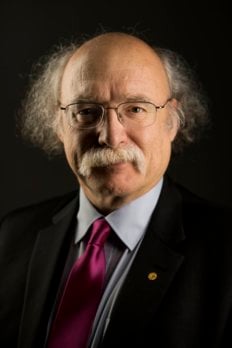
I was born in London in 1951, in a medical family who greatly valued science and education in general, but never tried to push their children to go into medicine, although my younger brother did choose that path. My father was a psychiatrist working in the newly-created National Health Service, and came from Scotland. He had wanted to become a psychoanalyst, but the war had prevented his planned training under Freud’s pupil Melanie Klein, and he was trying to find some way to apply techniques or insights inspired by psychoanalytic theory to the much more limited possibilities for psychotherapy in an NHS practice. My mother was a Carinthian Slovene from a bilingual region in southern Austria, who had met my father when he was an army doctor in the British Occupation Forces there. She was a medical student working in a hospital when she met him, but never managed to complete her studies after coming to Britain, because all the exams she had passed in wartime Vienna would not have been recognized, and she would have had to restart all the medical training from scratch, in what was, to her, a foreign language. Instead, she had a family. My parents’ backgrounds gave me a multicultural heritage, with relatives in both Scotland and in Austria, where we often visited for summer holidays, so I became reasonably fluent in German, but sadly my command of Slovenian remained very basic indeed. My mother was proud of her heritage, as was my father of his, and he would wear a kilt on formal occasions, so although I grew up in London, without a trace of a Scottish accent, I self-identified as half-Scot, half-Slovenian.
I was sent to private schools, first a mixed elementary school a short walk from our house in Bedford Park, in west London, where I appear to have excelled in subjects like arithmetic and spelling, but always lost out on my handwriting skills, which remained messy and irregular, despite my being made to copy out pages of text again and again (or so it seems in my memory). When I was ten, I was sent to the “preparatory school” (Colet Court) for St. Pauls School, and then to St. Pauls itself, which is a well-known “public” (i.e., private) boy’s school noted for a rigorous educational curriculum. The school was very cosmopolitan, and was mainly a day-school with pupils coming from many parts of London, with a small boarding component. I was one of the one hundred and fifty-three scholars at the school (the number has biblical significance as the number of fish miraculously caught by the apostles), and because of this, I wore a little silver badge in the shape of a fish.
I always remember being interested in mathematics and science. In English schools, at least at that time, one had to specialize early. Looking at the list of General Certificate of Education “O levels” that I took, they were English, Latin, French, mathematics, “physics-with-chemistry,” with the only unusual one being “physical geography and elementary geology.” At some point I had to choose between continuing with history or geography, and the rocks and minerals seemed interesting and I was fascinated by the crystal collection the school had (perhaps an early attraction to “condensed matter”?).
For “A” levels, I just have mathematics, physics, chemistry, so somehow, I never studied biology (I think one only studied it if one was planning to go to medical school?). Of course, as these last years of school were during the late sixties, there were lots of distractions for teenagers in London during that period, but I managed to keep my academics on track. In my final year at school, I had a very enthusiastic and inspiring physics teacher who got me interested in the subject, while previously I had found chemistry definitely more interesting.
Somehow, I managed to combine interest in science with interests in rock music and sixties counterculture. I had a gap of nine months after leaving school, and before starting University, and decided to travel. I worked for a while at a book publishers’ organization extracting data on names and fields of study of faculty members from German university catalogs, and with my savings, and a large backpack, then set off on the then-well-traveled overland trail to India and Nepal via Iran and Afghanistan (and back!) – a journey impossible today! (I would later get to see India (and Nepal) from a rather different perspective during visits as a professional Physicist.)
I was admitted to “read” Natural Sciences at Christ’s College, Cambridge where I “matriculated” in October 1970. Three subjects plus mathematics were required, so I finally had the chance to learn some cell biology as well as physics and chemistry, but I found I was not so gifted in the laboratory, and after an experience when I accidentally swallowed some nasty chemical I was supposed to measure out a small dose of using a “mouth pipette” (I do not believe such things still exist with today’s work-safety rules) I decided I should opt for prudence and focus on theory!
In my third and last Cambridge undergraduate year, 1973, I took a class called something like “advanced quantum mechanics” taught by Phil Anderson, where, if I remember correctly, he talked about the problem of localization by disorder, the Kondo effect, and other inspiring things. These were deeply conceptual quantum problems different from the diet of scattering problems which seemed like mathematical exercises in partial wave expansions and spherical harmonics that the more conventional classes had been feeding us. I was hooked and decided that if I was accepted to stay on at Cambridge as a graduate student in the Cavendish Laboratory (which happened), I would like to work with Anderson. I also considered working with Michael Green on an intriguing problem of “massless spinning relativistic strings”: since string theory as a model for the hadrons was abandoned shortly thereafter, and took ten years “in the wilderness” till it was repopularized as a possible theory of quantum gravity, my choice to work with Phil seems a fortunate one, at least for one made in 1973! It is probably the case that any successful research career can be traced to “accidentally” making a series of non-obvious choices at the right time, and various chance events. I think it was the concreteness of condensed matter, in that it was much easier to experimentally realize systems that exhibit all sorts of remarkable effects, that kept me on the condensed matter theory trail. In some sense, particle theorists have only one physical vacuum, with its beautiful but highly constrained Lorentz point-symmetry group, to play with, while condensed matter physics can “build” a huge variety of model vacua with different symmetry groups and “elementary particles” (elementary excitations), and play with them experimentally.
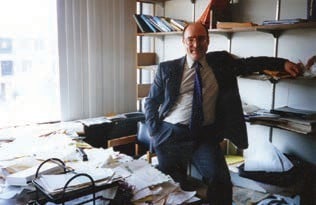
In the TCM (Theory of Condensed Matter) group at the Cavendish, Phil gave me the problem of “valence fluctuations” in the Anderson model of a magnetic impurities to look at and a reprint of his Les Houches lectures about the Kondo impurity spin model, including the “Anderson-Yuval-Hamann” renormalization group treatment of the mapping that turns the path-integral of spin-flips of the impurity into a coulomb gas of charges of alternating sign that interact with a logarithmic potential. This had a “renormalization group” (RG) treatment that provided the precursor for the method developed by Kosterlitz and Thouless for the Nobel Prize-winning solution of their famous problem. I also had to study Phil’s less-complicated “poor-mans method” that rederived the same RG scaling equations for the Kondo model. Phil spent part of the year in Cambridge and the rest at Bell Laboratories, so I had to work through these mysterious texts by myself. The majority of the TCM group were interested in accurate computation of material properties, especially surface properties of metals with different kind of atoms or molecules absorbed on them for catalysis, so in my advisor’s absence, I tried to learn from them and did not understand his “toy model” approach, which was that accurate details really do not matter if one is trying to understand the essence of some phenomenon, provided that the ingredients retained in the model are indeed the ones that matter.
I remember puzzling over the Kondo, Anderson and Wolff models which were all representations of something like a transition-metal d-orbital deep inside the core region of a transition metal atom, in which there are strong electron-electron interactions, mixing with a weakly-interacting metallic conduction band derived from outer s-like orbitals. I even got hold of a self-consistent Hartree-Fock program written in FORTRAN-66 line by line on a huge stack of IBM punched cards that had to be fed into a card-reader hopper to submit the job to a mainframe computer, and tried to puzzle out how the real orbitals of the notional metal atoms would behave as charge leaked off or onto the impurity atom from the metal background. Needless to say, all this was quite pointless, even though it was some kind of learning experience. When Phil returned again, I still had not figured out what the toy models really meant physically. For example the Wolf and Anderson models seemed to be mathematically equivalent, depending on whether the extra “d” orbital was interpreted as being part of the conduction band or orthogonal to it.
But instead of helping me struggle with these niggling details, when Phil returned, he gave a marvelous course of lectures that became his book “Basic Notions of Condensed Matter Physics” where he sketched his ideas of “adiabatic continuity” within phases until critical points were reached, and that all points within the same phase shared the same essential “fixed-point” independent of all the fine details. Through hearing him flesh out his ways of thinking, and going to see him about some details I was missing, and instead having him share with me his interesting thoughts about some apparently quite different but essentially related issue, I began to see his point of view that tries to identify what is needed to see the “big picture,” when trying to understand the physics of strongly-correlated systems. Somehow, that was what having a “mentor” was all about.
In the middle of my second year as a graduate student Phil announced that he would be exchanging his half-a-year at Cambridge, half-a-year at Bell Laboratories position for a similar one that replaced Cambridge University with Princeton University. I and Phil’s other student, Ali Alpar, who was working on pion superfluidity in neutron stars, never learned the reason for the move. This was in any case a very interesting change for us both, as Phil arranged to take us with him to the very different world of Princeton, New Jersey, starting with a few summer months at Murray Hill, New Jersey, the location of Bell Telephone Laboratories, then in its heyday. This was a tremendous privilege for a graduate student.
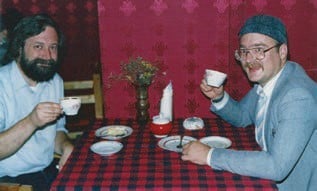
In September 1975, I moved down from Murray Hill to Princeton, and Ali Alpar and I shared an office on the fourth floor of Jadwin Hall, which was a larger office divided in two by partition, on the other side of which was Natan Andrei, working on particle theory with David Gross, and not yet on the Bethe Ansatz that he would go on to use to unexpectedly find the exact solution to problems I worked on such as the Kondo model, which I would tell him about. Other contemporary students on our floor included Ed Witten and Steve Girvin, who was working with John Hopfield on the “X-ray edge singularity” problem (which like the Kondo problem involved singular behavior at the Fermi level, especially the “orthogonality catastrophe” discovered by Anderson that affects dynamical degrees of freedom that excite particle-hole pairs in a metal that they couple to).
There were many blackboards on the fourth floor. One slightly disconcerting feature of the environment was that John Nash, the future Economics Nobel Laureate, who was in the middle of his illness, would gain access to the building at nights or weekends and systematically cover all the blackboards with mysterious equations connecting politics, pop culture, and numbers. Frank Wilczek had just become an Assistant Professor, and he gave a many-body class about the 3D interacting Bose fluid that I took. Barry Simon and Elliot Lieb were working on the stability of matter, which I also took a class on. Through Princeton and Phil Anderson, I was privileged to meet so many of the leading theorists who were at Princeton, or visiting; for example I was invited to dinner at the Andersons when Phil’s old friend David Thouless visited, meeting him for the first time.
It was an intellectually exciting time to be at Princeton, and in that atmosphere, I finally understood what I was trying to achieve with my extension to Anderson’s treatment of the Kondo problem that allowed valence (charge) fluctuations as well as spin fluctuations of an Anderson model impurity. The renormalization-group treatment showed a novel effect that there was a logarithmic temperature dependence of the energy level of the impurity orbital as a consequence of the interaction.
The renormalization group can be viewed as a way to resum a divergent series derived by perturbation theory, in this case in the mixing between the impurity orbital and the metal in which it is embedded. This means that the results can be validated by a detailed examination of the structure of the perturbation series. The test required that the sum of pieces of each of about forty distinct fourth-order terms in the series should exactly cancel. With the aid of the huge table of integrals by Gradsteyn and Ryzhik, I set out to do the test, but it did not quite work, the cancellation was just not happening. I checked and rechecked each of the forty terms time and time again, to no avail. Finally, after about two months of intense struggle, and being convinced that my results were correct, I realized that one of the complicated integrals I was taking from G&R could not possibly be right, because a simple approximation produced a lower bound that the printed result violated. When I worked out the integral for myself, there was a missing factor of two in the formula given in the tables, and the correction finally made everything work as expected. (When the next edition of G&R was published, there was indeed an erratum that corrected the printed formula!) The experience gave me confidence in standing by results I believed to be true, as well as a lifelong antipathy to doing high-order perturbation theory!
During my last year of graduate studies, the French physicist Philippe Nozières came to give a seminar, and Phil introduced me to him. Later, just when I was wondering where to apply for a postdoctoral position, I got a letter offering me a five-year position in France, at the Institut Laue-Langevin in Grenoble, a city with a large number of research laboratories. The ILL is a neutron-scattering facility, a joint consortium between France, Germany, and Britain, but had a theory group as well as experimental groups who used the neutron source. The idea of experiencing a new country, France, was very appealing, and especially as the dollar was at a low point of the exchange rate, the job looked very attractive, so I accepted. I finished writing up my thesis, and before leaving for France, I had the great opportunity to attend, with Phil’s recommendation, a workshop on strongly-correlated electron systems at the Aspen Center for Physics, in Aspen, Colorado, and then spend a month with Sebastian Doniach at Stanford University.
My brother came to visit, and shared the driving in my old VW beetle from Princeton to Aspen, and it was quite amazing to experience transcontinental driving! That year was a special year at Aspen, as a high-powered delegation from the Landau Institute in the USSR, led by Lev Gorkov, was also attending the workshop. My future colleague Sasha Migdal was among the Soviet party, and it was very interesting to witness the internationalism of science. (There was also a lot of speculation about who was acting as the KGB minder who it was assumed had to be there to keep an eye on the rest of the delegation!) This was followed by a further drive through the spectacular western scenery to Stanford, where I met my future long-term collaborator Ed Rezayi, then a graduate student with Doniach, and then another transcontinental drive back across the US to New Jersey, from where I left for France.
I had perhaps foolishly shipped my American-model Volkswagen to France, but picked it up at the port of Le Havre, and was driving down the autoroute to Grenoble when I heard on the car radio that Phil Anderson was to share that year’s Nobel Prize for Physics with his advisor John Van Vleck and Nevil Mott, who had brought him to Cambridge in the sixties.
I soon found that while my years of French language studies at school had prepared me to decipher street signs and read menus, understanding what people were saying was another matter. On the other hand, the multinational work environment at the ILL was mainly English-speaking, which did not help to improve my French. This was remedied after I met Odile Belmont, a native of the Grenoble region who would later become my wife.
In learning about the Anderson-Yuval-Hamann treatment of the Kondo model I learned about the X-ray-edge singularity problem, which Nozières and de Domincis (ND) had solved in terms of singular integral equations, and the much simpler later variant treatment by Schotte and Schotte using “bosonization,” a remarkable and mysterious representation of electron creation operators apparently just using harmonic oscillator variables, related to those used by Tomonaga in his 1950 treatment of sound waves in a one-dimensional Fermi gas. The two treatments agreed at weak coupling, but differed at strong coupling, where the ND treatment seemed more complete, but in fact the model assumptions used in the two treatments were slightly different, so the models were different at strong couplings. I became aware that Daniel Mattis had claimed to solve the Wolff model exactly using bosonization techniques, but I knew that, at least formally, the Wolff and Anderson magnetic impurity models were equivalent, and from my thesis work, felt something was not right with the proposed bosonization solution. One of my new colleagues at ILL, Hans Fogedby, was also working on the Wolff model with Mattis’ technique, and I determined to try an understand the bosonization technique, and find out why it was giving results I disagreed with, including a phase transition to a magnetic state as the short-range (contact) interaction strength (usually denoted “U,” by analogy to the Hubbard model, a widely-used “toy model” for studying magnetism) was increased.
The Anderson and Wolff models feature a single “impurity orbital” in which there is a Hubbard “U” coupling. Because the Pauli principle prevents two electrons with the same spin from being present in the single impurity orbital, there is no direct interaction between electrons with the same spin, and these were explicitly discarded in the bosonization treatment. However, while the ND treatment of the X-ray edge problem, preserved the contact-type nature of the interaction, the bosonization treatment was secretly treating a long-range interaction which could couple electrons of the same spin, so it was not valid to simply discard same-spin interactions. This subtlety was hidden in the now-explicitlyspecified “ultra-violet cutoff ” structure, invalidating the bosonization treatment of the Wolff model, but I wanted to “clean up” aspects of the bosonization technique, which had been recently also been used to great effect by Luther and Emery for one-dimensional metals, and by Luther and Peschel for the spin-1/2 easy-plane spin chain.
At this time, the correctness of the Kosterlitz-Thouless treatment of the topological phase transition had not yet been universally acknowledged, and there was a counterproposal by Luther and Scalapino based on bosonization of a 1D quantum spin chain. I attended a workshop at NORDITA in Copenhagen, where Luther had moved to, where this was a heated subject of discussion. At that meeting I also first met my future colleague Kazumi Maki, and there was also a Soviet contingent, including Igor Dzyaloshinksky of the famous Landau-Institute AGD (Abrikosov-Gorkov-Dzyaloshinsky) triumvirate, who had produced the foremost text on diagrammatic perturbation methods in condensed matter theory. Igor was an old friend of Philippe Nozières, and I got to know him well when he subsequently came for an extended visit to Grenoble. He had produced an interpretation (with Anatoly Larkin) of bosonization in terms of standard diagrammatic perturbation theory, which was a useful alternative viewpoint.
In my investigation of bosonization, I found that its exact formulation needed two action-angle variables to replace the absent zero-wavelength sound-wave mode, and the lack of this in the earlier formulations such as Luther’s had been “patched up” with a cutoff that was not really consistent. The new variables added topological winding-number excitations with their own distinctive energies to the well-known Tomonaga sound waves, and allowed me to formulate what I called “Luttinger liquid theory,” first as a replacement for Landau Fermi-liquid theory in one dimensional electron systems. However, because “2kF” for a spinless Fermi fluid would also be the Bragg vector if the fluid crystallized, it also applies to 1D Bose fluids and gapless uniaxially-anisotropic spin chains. As I described in my Nobel lecture, this led to a a deeper understand of spin chains, including my very expected discovery in early 1981 that the spin-1 isotropic antiferromagnetic chain had a gapped spin-liquid state that is now recognized as an early example of topological quantum matter.
I was quite surprised when analysis starting with the Luttinger-liquid approach, supplemented with the mapping of the Kosterlitz-Thouless transition to (1+1) dimensional quantum mechanics, led inescapably to my surprising conclusion. I was even more surprised at the resistance this received from the quantum magnetism community when I submitted the paper for publication: it was rejected by multiple journals, and was labeled a “conjecture” even though it was, in my mind, a clear prediction. I recall that one referee pontificated that my claims “were in manifest contradiction to fundamental principles such as renormalization and continuity”! Of course, my predictions were later vindicated both by numerical studies and experiments.
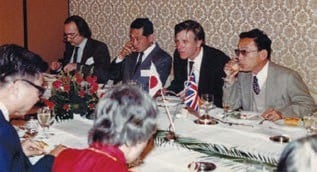
While in France, I received an unexpected invitation to visit the University of Southern California in Los Angeles for a job interview. It turned out that Kazumi Maki had written to Philippe Nozières asking for suggestions for candidates. I visited, and was seduced by the beach and palm trees. I had not yet actively started to look for a faculty position, but at that time, the news I was hearing from British friends was anecdotally rather pessimistic about the UK physics job market, and government research funding. So by default, I inadvertently joined the “brain drain” to the US. A lasting legacy from my time in France was my French life-partner Odile, who agreed to try out the California lifestyle with me.
In my last year at the ILL, I was fortunate, perhaps as a result of my “Luttinger liquid” work, to be invited to one of a small group of “promising young scholars” invited to a Taniguchi Symposium in Japan where the Japanese philanthropist Toyosaburo Taniguchi envisaged they would come together to interact in ideal and luxurious surroundings, in this case a lodge next to Mt. Fuji. Not all the “scholars” were that young, and I had the chance to meet and discuss with John Hubbard, who had introduced a key “toy model,” the Hubbard model for strongly-interacting electrons, who was also there, and seemed to be enjoying the meeting. (Tragically, it was his last meeting, as he died just after returning home.)
By the time I got an extensively rewritten paper on the spin-chain finally published (in Physics Letters A) I had been in California for over a year. During that time I received two papers (from the same journal) to referee (first by Takhtajan, then by Babujian) both describing an exactly solvable gapless S = 1 spin chain with a Bethe Ansatz solution very similar to the gapless S = 1/2 chain. The exact solutions were claimed to represent the generic behavior of arbitrary-spin Heisenberg antiferromagnets, and they apparently completely contradicted my theory! I must admit I had about ten minutes of self-doubt when I received the first of these papers, but soon saw that the solvable model was a modified model with a large non-Heisenberg unphysical “biquadratic exchange” term, and did not represent the standard Heisenberg model I had treated. Furthermore, though they were gapless, I could not fit them into my “Luttinger-liquid” picture. Around this time, (1+1)-d conformal field theory was starting to be developed. Eventually it emerged that “Luttinger liquids” were related to Abelian conformal field theories, that can have continuously tunable critical exponents. The new S> 1/2 Takhtajan-Babujian solvable models were critical, but correspond to nonAbelian conformal theories that require fine-tuning the couplings to exactly cancel “relevant” perturbations, so do not represent generic spin chains. The S = 1 case represents a critical point between the generic “Haldane-gap” nondegenerate symmetry-protected topological (SPT) state, and a non-topological gapped broken-symmetry two-fold-degenerate dimerized state.
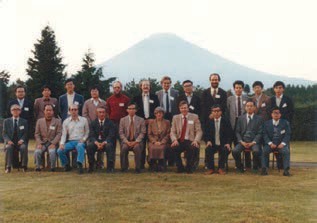
An apparently unconnected series of surprises were independently discovered in those years. First, Klaus von Klitzing discovered the integer quantum Hall effect (QHE). As soon as it had been concluded that, in two dimensions, localization by a disordered potential would always lead to integer quantization of the Hall conductivity, Dan Tsui, Horst Störmer and Art Gossard discovered the fractional quantum Hall effect. This was far more of a shock for theorists, as the understanding of the integer QHE showed a fractional effect could only occur as a consequence of interactions. Furthermore, at the time it was generally believed that second quantization and diagrammatic perturbation theory was the principal tool for understanding interaction effects. In fact these techniques are only useful if some adiabatic connection can be found between a non-interacting system and the interacting one, which was not the case for this problem. The Soviet physicists at the Landau Institute outside Moscow were the world’s leading practitioners of diagrammatic techniques in condensed-matter physics, and interestingly, the fractional QHE was the first problem to which they were unable to make many contributions.
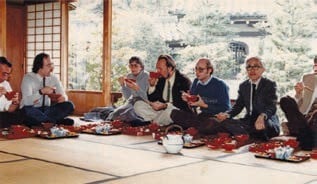
Of course, the key breakthrough was Laughlin‘s discovery of his eponymous state, apparently through carrying out a numerical diagonalization of a threeparticle system projected into the lowest Landau level. Perhaps his training in band-structure calculation allowed him to take this direct route to investigate the problem. The key experimental clue was that the QHE states occurred at Landau-level filling v = 1/3 but not at v = 1/2. I had been thinking about some kind of “supersolid” picture, when in early 1983 I received Laughlin’s paper to referee. Within ten minutes I knew he had found the right (Nobel prize-winning) explanation, an incompressible quantum fluid with fractionally-charged excitations, that was later realized to be topologically ordered. In addition, it was fundamentally disconnected from free-particle Slater-determinant states, so there seemed to be no hope of understanding it based on diagrammatic perturbation theory. The most convincing detail was that it provided a natural explanation based on Fermi statistics for why it occurred at v = 1/3 but not v = 1/2. The wavefunction also provides a clear picture of what was later called “flux attachment.” The Laughlin state had a huge effect on the way I thought about condensed matter physics.
Later that year, there was a meeting at Bell Laboratories to celebrate Phil Anderson’s sixtieth birthday, and I stopped over in New Jersey on my way to France, for a summer collaboration with Rémi Jullien, Robert Botet, and Max Kolb, who done the first numerical studies to test my claims about the integerS antiferromagnetic spin chains, and had also attracted skepticism when they reported results supporting my predictions. I had a very interesting discussion about the Laughlin state with Phil, who noted that if three units of flux were injected at a point to create three concentric quasiholes, the resulting state was the same as that resulting from locally removing an electron from the Laughlin state. Thus adding three units of flux plus one electron would just change the N-particle state to the (N + 1)-particle state, in analogy to a Bose condensate where particles were composite objects. Independent of Laughlin’s work, a numerical exact-diagonalization study had also independently been carried out with (quasi)periodic boundary conditions by Yoshioka, Halperin and Lee (YHL) in an anisotropic basis which seemed to suggest a liquid state with a three-fold degenerate ground state, but was not as revealing as Laughlin’s picture.
I had been wondering how to do a numerical calculation that incorporated isotropy, without the problem of boundaries, which YHL avoids. That night, I was staying as a guest in Chandra Varma’s house, and woke from a dream in the middle of the night with the image of a spherical surface around a magnetic monopole, which solved the problem, and turned up to be an incredibly powerful tool for numerical investigation of the fractional QHE. I suppose my brain had been churning over my discussion with Phil Anderson earlier that day, to produce this Kekulé-like experience. Having woken up, I worked out all the details there and then.
I flew on to France, but instead of working on spin-chains with Rémi Jullien and his group, I found that their spin-chain programs were built with arbitraryrange exchange, which allowed me to use them “as-is” (for bosonic Laughlin states) to test ideas suggested by the spherical geometry, such as the powerful pseudo-potential idea, and the idea that the Laughlin state was an exact eigenstate of a “toy model” that retained only short-range components of the interaction potential, analogous to the Hubbard model, except without a background lattice.
In France, I learned the basic techniques of the Lanczos sparse-matrix diagonalization method. When I got back to Los Angeles, I was coincidentally contacted by Ed Rezayi who had just moved there, and we began a fruitful collaboration on numerical studies of the fractional QHE. Because of the inapplicability of diagrammatic methods for this problem, these have been the only quantitative source of information about energies and stability in the problem, to date.
The next year I received an interesting job offer to join Bell Laboratories as a member of technical staff. I took a leave of absence from USC, and we moved to New Jersey, one month after our son was born. It was just the time of telephone deregulation, and of the split between AT&T Bell Laboratories, and BellCore, the part of the research division going to the new local telephone companies, and who were still in the same building as us for several months more. There was fantastic research going on at the Bell Labs, but in the end I decided that I missed the academic environment of a university and accepted a position at the University of California, San Diego, starting at the beginning of 1987, where I stayed until mid-1990. The effect of breaking up the Bell telephone monopoly inevitably led Bell Labs to decline to a shadow of its former self over the succeeding thirty years.
In January 1987, we moved to La Jolla, California, with its beautiful weather and beaches. At that time I was working on both quantum magnetism and the fractional quantum Hall effect. While at Bell Labs, as soon as I heard a rumor that Ian Affleck, with Tom Kennedy, Eliot Lieb and Hal Tasaki (AKLT) had come up with a variant spin-1 magnetic chain model for which the ground state could be exactly found (the AKLT state), I correctly immediately knew, with no further details, that it had to work by the same “pseudopotential” idea that made the Laughlin state an exact eigenstate of a truncated short range interaction. At UCSD, Assa Auerbach and Daniel Arovas, who were postdocs at the University of Chicago had asked to come to visit La Jolla during the Chicago winter, and do some work on quantum magnetism. They found a beach motel to stay for a month, and we were able to get very nice insights into the excitation spectrum of the AKLT model using methods borrowed from the fractional quantum Hall effect, in the process starting a lifelong friendship. Interestingly, this work provided the first clue that there could be some relation between the spin-chain and the quantum Hall effect: this is now clearer, as both are now recognized as forms of topological quantum matter.
In this period at UCSD, I came across various interesting results, such as an exactly-solvable spin chain model with long-range exchange (independently discovered simultaneously by Sriram Shastry, and now called the “Haldane-Shastry” model), in which the “spinons” of the spin-1/2 chain are especially simple.
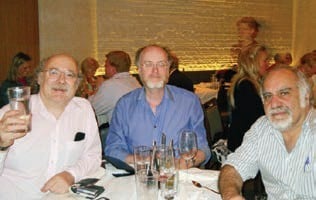
I also came up with the second discovery that the Nobel committee mentioned: I called it the “zero-field quantum Hall effect,” but it is now usually called the “quantum anomalous Hall effect” or the “Chern Insulator,” and is the first member of the topological insulator family, but one with broken time-reversal symmetry, unlike the later time-reversal-invariant topological insulators. The idea was started when I read a 1986 paper in Physical Review Letters (PRL) by Eduardo Fradkin, Elbio Dagotto, and Daniel Boyanovsky (FDB), called “Physical Realization of the Parity Anomaly in Condensed Matter Physics.” I am not sure if I understood it properly, but it seemed to propose a quantum Hall effect in the absence of a magnetic field and with unbroken time-reversal symmetry, on a domain wall in a semiconductor with strong spin-orbit coupling. This interesting paper also stimulated Frank Wilczek to think about axion electrodynamics in a condensed-matter context. But thinking about it, I realized that there was no problem with a QHE in the absence of magnetic field, provided time-reversal symmetry was broken, which explicitly was not the case in the FDB paper. I tried to make this point by submitting a “comment” to PRL on the FDB paper, but as is often typical in this kind of “Comment/Response” dialog, it really became two monologs, where neither side understands what the other is saying.
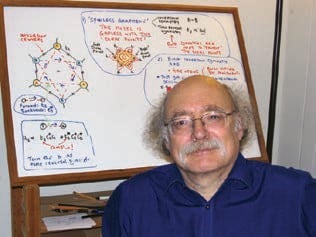
In the course of sharpening my arguments, I looked for as simple and transparent a model as possible with which to make my point, and since Gordon Semenoff has used a “graphite monolayer” (i.e., graphene) as the condensedmatter backdrop for Dirac points, I used that too. The 2D Dirac points are stable if both spatial inversion and time-reversal symmetries are unbroken: Semenoff broke inversion symmetry to get an entirely-unremarkable insulator that had a field-theoretic description as two copies of a massive Dirac equation. With a bit of magic involving complex second-neighbor bonds, I broke time-reversal symmetry and ended up with a topologically-non-trivial state exhibiting a “quantum anomalous Hall effect” where “anomalous” in this context means that the Hall effect is not driven by a uniform magnetic flux density, but arises from magnetization. At this point I realized that this effect was extremely interesting in its own right, especially if could be realized experimentally in a real material. I dropped out of the Comment/Response cycle, which in any case was getting nowhere, and published the result in its own right.
The model of graphene with a “mass gap” due to breaking of time-reversal symmetry, conceptually provided by an additional ferromagnetic degree of freedom with a magnetic moment normal to the graphene sheet, was a simple and transparent enough “toy model” to be used for a number of model calculations. As well as the gapped quantum anomalous Hall regime, it had a metallic regime, with the Fermi level inside a band, which could model a 2D version of a metallic (unquantized) anomalous Hall effect, and David Vanderbilt and coworkers later put it to good use to find and test a general Berry-like formula for the magnetization of a material in terms of its bulk bandstructure. I later also used it to guide me to new expressions for the anomalous Hall effect in 2D and 3D metals as a pure Fermi-surface formula, which is relevant to the currentlyhighly-studied “Weyl semi-metals.”
Later in 1988, I had two very interesting foreign trips, one to the People’s Republic of China, where T. D. Lee organized a meeting at Beijing University with a cast of colleagues such as Bob Laughlin, Steve Kivelson, Ganapathy Baskaran, Dung-Hai Lee, and others. This was when it was just becoming possible to travel to the PRC, and the Beijing streets were still rivers of bicycles, unlike today. In the second trip, I was invited by David Pines, to join a party sponsored by the National Academy of Sciences to visit the USSR, in particular the Landau Institute at Chernogolovka, which had long been off-limits to westerners (we were in fact the second group of western visitors to visit). There I met such future condensed colleagues such as Paul Wiegmann, who also independently solved the Kondo problem (and who a year later was able under Perestroika to get a passport to come with his family to a visiting position at UCSD), and my future Princeton colleague Sasha Migdal, as well as meeting senior Soviet physicists such as Gorkov, Abrikosov, and Khalatnikov. Everyone in the visiting party at the Landau Institute also wanted to meet my renowned future Princeton colleague Sasha Polyakov, but then, as now, he was a fanatical jogger, and was out running somewhere in the woods and could not be found! After a day at the Landau Institute, we went on to a meeting in Tbilisi, which was greatly enjoyed by our hosts, as the alcohol ban that Gorbachev had decreed in Moscow did not extend to Georgia. While meetings between physicists from the US with those from Russia and China are commonplace today, at the time these were quite exceptional experiences.
In 1990, Princeton University successfully enticed me away from California, and with a new baby daughter, we moved back to the East Coast. Princeton, long known for elementary particle physics, was building up its condensed matter group. In 1992, I spent a half-year sabbatical at the École Normale in Paris, and after giving a seminar on the mysterious symmetries of the Haldane-Shastry model, which a year earlier had led me to formulate a novel “fractional exclusion statistics” a suggestion from Vincent Pasquier and Denis Bernard led the identification of an unusual form of the “Yangian quantum group.” In 1993, while attending a workshop, I unexpectedly learned from Steve Kivelson that I was that year’s Oliver Buckley Prize winner for the old quantum spin chain work: it turned out that that had been announced a few weeks earlier, but I had mistaken the large white envelope with the APS letter for some routine circular, and left it unopened, and no-one else had told me. This must have been the days before email was widespread! A few years earlier, David Thouless had told me he was nominating me for Fellowship of the Royal Society of London, and (perhaps because of the Buckley Prize) I was finally elected in 1996 and had the honor of signing the parchment Charter Book, with entries going back to Newton.
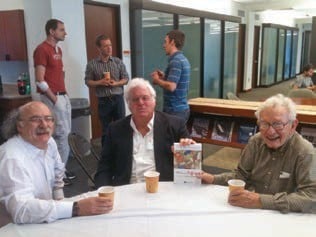
For a long time, nothing had happened with my 1988 graphene-like toymodel for the zero-field quantum Hall effect. In 1999, work by Ganesh Sundaram and Qian Niu (a former graduate student of David Thouless) revived the longignored work of Karplus and Luttinger on the anomalous Hall effect in ferromagnetic metals, showing that it had a modern interpretation in terms of Berry curvature. This re-energized the study of Berry curvature effects in band structures. My 1988 model satisfied the “TKNN” topological result of David Thouless, with coworkers Mahito Kohmoto, Marcel den Nijs, and Peter Nightingale, that was cited by the Nobel committee as David Thouless’s seminal contribution to topological matter. When the gap was opened by breaking time-reversal invariance the conduction and valence bands had Chern invariants ±1 respectively.
In the early 2000s after attending a seminar by John Joanopoulos on the new subject of “photonic crystals” where the flow of light is modified by passing it through engineered spatially-periodic “metamaterials,” I realized that, at least as far as “one-way” edge states were concerned, some of the physics of the quantum anomalous Hall effect could be transplanted into the field of photonic crystals, which could also have Chern invariants. Still it took some time to come up with an explicit photonic bandstructure that would this. Eventually, in early 2004, while I was on sabbatical at UC Santa Barbara, my student Srinivas Raghu, who came with me, found a candidate structure inspired by the same hexagonal graphene structure that exhibited the electronic effect in my 1988 model. A calculation confirmed that it indeed would show the effect, and the new field of “topological photonics” was born.
At that time, there was also a lot of discussion about a “spin Hall effect” in systems with spin-orbit coupling and unbroken time-reversal symmetry. As a toy model, it was natural to combine conjugate copies of the 1988 model for what could now be called the “quantum anomalous Hall effect” to form a time-reversal invariant structure that would exhibit a “quantum spin-Hall effect.” While at UCSB, I played with this model, but because it had edge modes that traveled in opposite directions, I assumed that it could not represent a true stable topological phase because spin-non-conservation by generic Rashba spin-orbit coupling would surely mix and destroy the edge modes because the total Chern invariant satisfied 1 − 1 = 0. This is a good lesson for not assuming things without actually doing a calculation! Charles Kane and Eugene Mele has the same idea, but actually tested it with a numerical calculation, and realized that the quantum spin-Hall state was indeed topologically stable because of a previously-unrecognized topological invariant. Furthermore, a few years later, in 2007, it was simultaneously realized by a number of groups that this new invariant could be extended to three dimensional materials, now called “topological insulators.” This was shortly followed by the discovery by Liang Fu and Charles Kane of an extremely simple formula for determining whether such insulators with additional inversion symmetry were “topological” or not, leading to many experimental discoveries of topological materials, and an explosion of interest in the field.
In this period of the discovery of time-reversal-invariant topological insulators, my own work focused on rather different problems of the role of geometry rather than topology in the fractional quantum Hall effect, but in 2008, my student Hui Li and I discovered remarkable topological features in what we called the “entanglement spectrum” of quantum states, showing how the detailed structure of the entanglement revealed by its Schmidt decomposition contained far more information than just the single number characterizing entanglement entropy. This has turned into a widely-used diagnostic for studying the topology of entanglement.
In 2012, I was very gratified when the role that the 1988 “zero-field Hall effect” model had played in the topological insulator was recognized when I shared the prestigious International Centre for Theoretical Physics Dirac Medal with Charles Kane as well as Shoucheng Zhang, whose work with Laurens Molenkamp had led to a physical realization of the 2D quantum spin-Hall effect.
Finally in 2013, Shoucheng Zhang’s collaboration with the experimental group at Tsinghua University in Beijing, where magnetic material was deposited on the surface of a layer of 3D topological insulator, finally led to the experimental realization of the quantum anomalous Hall effect envisaged in my 1988 paper. Because of the robustness of the unidirectional edge states, these materials are potentially even more useful than the time-reversal invariant topological insulators.
Finally, this chapter of my story ends in October 2016, when I was awakened by the 5:00 a.m. phone call from Stockholm, followed by the magnificent ceremony and banquet there on the 10th of December. While my mentor Phil Anderson was not able to travel to be in Stockholm in person, he passed on tips and observations he had made when he received his own Nobel Prize in 1977. John Van Vleck, Phil Anderson’s thesis advisor, who shared the 1977 Nobel Prize for Physics with him, had as thesis advisor advisor Edwin Kemble, who, while he himself did not win the Nobel Prize, had an advisor Percy Bridgman who was the sole Physics Laureate in 1946. So I discovered I have an illustrious “academic gene line,” stemming from fortunate choices I made back in 1973!
This autobiography/biography was written at the time of the award and later published in the book series Les Prix Nobel/ Nobel Lectures/The Nobel Prizes. The information is sometimes updated with an addendum submitted by the Laureate.
Nobel Prizes and laureates
Six prizes were awarded for achievements that have conferred the greatest benefit to humankind. The 12 laureates' work and discoveries range from proteins' structures and machine learning to fighting for a world free of nuclear weapons.
See them all presented here.
